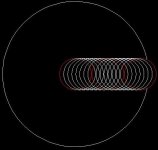supergreenman said:HalI just made the size of the tip small so it would stand out. As some previous posters have said, the whole tip doesn't make contact with the CB.
The point I was trying to make is that you should be starting your count with the left hand edge of the tip on the very centre of the CB, not half a tip away like your illustration.
I dont know how we are supposed to look at but in my head I see the tip widths the same way you do.
1 tip of right would be that the tip is 1 tip right on dead center. This would have the left edge of the cuetip at dead center.
2 tips would have the left edge of the tip equal to where the right edge
of the cuetip was when it was at 1 tip.
I believe that is the way you view it as well.
I really dont think the it matters as long as we understand our own view.
When coaching or relaying information it becomes a little more difficult.
I do think that with both objects (tip and ball) it allows for more contact farther out than what a 2D drawing can show. What it does help to think about is how critical it can be to have a flat tip or one that is too rounded.
Which is closest to a cueball radius? dime shaped tip or a nickle shaped tip
